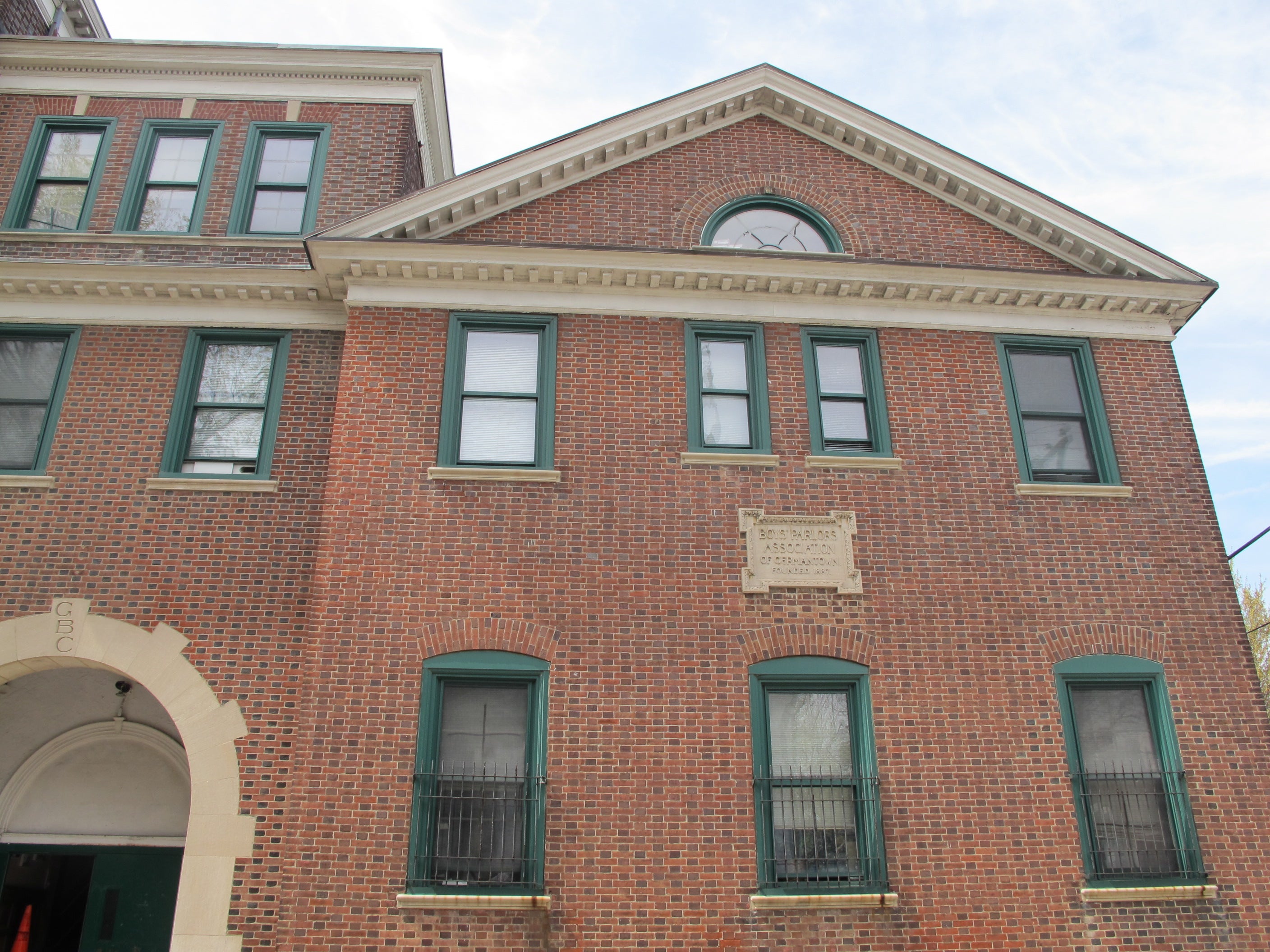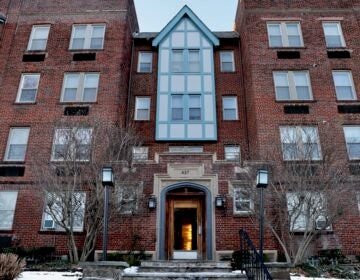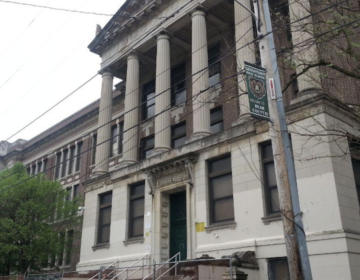In Germantown, a fight over a century old building and the future of the Boys and Girls Club

Everyone agrees that the super-sized Boys and Girls Club slated for Germantown will do wonders for the neighborhood.
But beneath that gauzy consensus a controversy is brewing about the design and location of a state-of-the-art $20 million ice rink and educational facility. The fate of the Boys and Girls Club site speaks to the identity of the neighborhood — one of the most architecturally rich in the city — and its painful history of white flight, redlining, and subsequent poverty.
The Philadelphia Boys and Girls Club’s Germantown location stood sentinel over all that history and bears the scars to prove it. Almost two years ago, Comcast began a huge fundraising drive that would allow the youth organization to demolish the 119-year-old facility and erect a massive modern building, increasing capacity fourfold. The new facility will be named after Ralph Roberts, the recently deceased founder of Comcast who grew up in Germantown.
Neighbors first learned about the project in the newspaper, reading that Comcast’s generosity would soon lead to the old club’s destruction. When the co-CEO of Boys and Girls Club of Philadelphia, Lisabeth Marziello, held a public meeting about the project, she faced unexpected pushback from near neighbors and the Penn Knox Neighborhood Association. The crowd feared the new project would overwhelm Penn Street, which is a narrow one-way residential block. They also didn’t want to see the old club demolished.
The project cannot be completed by-right, so Marziello’s plan requires a zoning variance or a legislative remapping. The club got a zoning permit to perform the demolition, but they have not yet received the necessary demolition permit itself. As for funding, Marziello declined to provide a current cost estimate, saying only that the project is on track to meet all its goals.
This Monday night the Enon Tabernacle Baptist Church will host the first meeting on the proposal since 2015 that actually features Marziello. Then, on Wednesday morning, the Committee on Historic Designation will consider a nomination that seeks to add the current Boys and Girls Club building to the historic register.
As these flashpoints approach, the fault lines in the community may widen. For the local groups who have critiqued the project, it makes little sense to demolish a salvageable neighborhood icon in a corner of the city that prides itself on its architectural legacy—especially as the Preservation Alliance cites Germantown as the second most endangered historic section of the city.

They argue that a massive new investment like this shouldn’t be directed to this corner of Germantown, which is already rich in institutions. Germantown Friends School’s campus is immediately to the north, while the Wissahickon Boys and Girls Club lies a half mile to the southwest.
“This is going to be huge for Germantown, the biggest investment in years,” says Sue Patterson of the Penn Knox Neighborhood Association. “Our side of Germantown is pretty well endowed. I think east Germantown should get this as a shot in the arm. Even if, in the end, it does end up here we just feel like there should be an actual conversation.”
Meanwhile, Marziello and her team are mystified that anyone would do anything to complicate a significant investment in afterschool activities in an area where half the children live in poverty. They already own the land. Why make things any more complicated than they have to be?
“We’ve been here for 130 years and we need to be there for another 130 years,” says Marziello. “We have no plans to desert our site. The building cannot be adapted to meet the modern needs of our club. It is dilapidated and really not conducive for the needs of our community.”
The Boys and Girls Club’s proposal enjoys the support of Germantown’s district councilperson, Cindy Bass. The community meeting on Monday night will be held at Enon Tabernacle, another community fixture in support of the project.
Nonetheless the Penn Knox Neighborhood Association, local preservationists, and many neighbors in the surrounding blocks have organized to protect the old Boys and Girls Club building. In July of 2016, they submitted a historic nomination, highlighting the building’s red brick masonry and foundation of Wissahickon Schist, as well an early history as a center for social life — although in the beginning the club only served white youth — as Germantown became denser and more working-class in the early 20th century.
In February, Penn Knox began circulating petitions opposing the demolition of the building and the construction of a hockey rink that they described as “inappropriately oversized relative to the location, on a tiny one-way street.” The petitions garnered over 225 handwritten signatures, along with 234 online signatories.
At the same February meeting, Penn Knox agreed to provide suggestions for alternative spaces. Germantown is filled with vacant land that could use investment, they reasoned, and there are many areas that could use an institutional anchor to combat blight.

They eventually drafted a list of ten sites in the same zip code as the Boys and Girls Club, with other prominent locations including the old Germantown High School, shuttered in the recent wave of closures.
Patterson sent the alternates list to Marziello, Bass, and Anne Fadullon, the city’s director of planning and development. No one responded.
Marziello says they have no interest in considering an alternative site.
“We were there before anybody else in the neighborhood,” said Marziello. “They moved into the neighborhood knowing that the Boys and Girls Club was there. We just want to improve it for the kids in the neighborhood who need it most. Why would you want to bus them out of your neighborhood? We are doing this for the good of the cause.”
The February Penn Knox meeting was also attended by Ken Weinstein, one of the largest developers in Germantown. He alone among the group had attended the original unveiling of the project and also attested to a hard hat tour of the building back then with Marziello.
“I found it to be very structurally sound, although it’s in terrible condition,” said Weinstein, whose company is known for adaptively reusing rundown historic buildings. Weinstein disputed Marziello’s description of the current Boys and Girls Club as “not salvageable.”
“I really had a change of heart about the project when she came here and said everyone who has looked at the building agrees it should be torn down,” Weinstein said at the February meeting. “I had told her just the opposite.”
Although L&I issued an unsafe building designation for the property, the dangerous condition is limited to a small area in the rear that is far from the sidewalk. L&I commissioner Dave Perri says the building is structurally and operationally sound, and his department’s order isn’t “a pretext for demolishing the entire building.”
If the proposal does move forward as currently planned, Weinstein hopes the old building could be incorporated into the new construction. But he agrees with Penn Knox that a project of the proposed magnitude would be better served elsewhere in Germantown. Weinstein prefers reusing the old high school, because it has sat unused since 2013, fronts onto a broader one way street, and is less than a mile away.
“This isn’t a typical NIMBY situation,” says Weinstein. “If it were, I would be on the other side.”
“No one opposes the idea of a larger Boys and Girls Club. This would be a great thing for Germantown. It just doesn’t need to be at this location.”
DUELING NARRATIVES
Marziello says she is more than ready to make smaller concessions to the community based on the critiques the Club heard in 2015. She notes that they own property on Coulter Street just to the north of Penn Street and that they have a plan there to alleviate parking concerns. They are also planning to use brick and stone construction materials to pay homage to the historic look of Germantown.
For supporters of the current plan, the mission of the Boys and Girls Club — providing a safe, supportive environment for Germantown’s children — completely outweighs concerns about preserving history, respecting neighborhood scale, and bringing resources to other corners of the neighborhood. If Marziello says this is the best way to do that, then this what she should get.
“I think supporting it at that location makes the most sense, by enhancing what is there,” says Councilwoman Cindy Bass. “The existing building is falling apart.”
“The Boys and Girls Club… are in desperate need of pro-quality facilities,” she said. “If it’s not wanted there, well, I just don’t understand why that is the case.”
There are less charitable interpretations about the reasons why community groups like the Penn Knox want to debate the project. The neighborhoods on the west side of Germantown Avenue have a large white minority and a narrative is circulating that they oppose the expanded Boys and Girls Club for racial reasons.
Although several residents mention that they’d heard this narrative, the only person who said as much is George Thomas, an architectural historian who provides research on the site’s history for Marziello.
“They never cared about the building until the other club was offered,” says Thomas, who is often brought in by developers to counter preservationists on their own terms. “You are being led on by a group that is being disingenuous with you, they aren’t laying out what their issues really are. It has been very clear to me in my research that there is another story.”
Thomas says that the Penn Knox Neighborhood Association’s actions are of a piece with a long history of racist white reaction to the African American presence in the neighborhood.
“To me, Germantown is an area where there’s real cultural problems about conflict, race, and privilege,” says Thomas, who is white (as is Marziello). “It’s the whole history of Germantown in the 20th century. Everything Germantown has been about has been reflecting the conflict of the African American community moving in. It’s a real problem.”
Members of the Penn Knox Neighborhood Association rejected that interpretation of their opposition, many of whose members moved to this part of Germantown because of its beautiful old housing stock and its history of integration. (Although the census tract that includes the Boys and Girls Club is majority black, as is every one of the tracts adjoining it, many of the neighborhood group’s members are white.)
“People who love diversity live here because of that and people who love old homes and big trees live here because of that,” says Patterson, who is white. She is unfamiliar with Thomas but has heard that similar narratives are being propagated. “That’s why this issue of is this a racial thing is crazy to me. You really aren’t going to bump into that kind of person here, because they wouldn’t choose to live here.”
A visit to the area on a recent sunny afternoon showed Penn Street alive with activity despite a clutch of underutilized parcels. Small groups of children, all of them African-American, periodically buzzed along the sidewalk chatting with their friends. Neighbors both black and white popped in and out of their rowhomes. Most people on the block signed the petition protesting the Boys and Girls Club’s plan, but the existing facility and the expansive green of its playing field is still seen as a real boon.
“I wish they’d think more long term instead of just trying to build it as quickly as possible,” says Martha Savery, a white woman living on the block who was nervous talking to a reporter about the project lest she be viewed as racist. “They could benefit Germantown more if they were more thoughtful with their placement of this development. But my kids would certainly use it [an ice rink] if they do open it here.”
*This story has been updated to reflect that the historic nomination was submitted before the zoning permit that clears the way for a demolition permit; and to clarify that the kick off was open to the public.
WHYY is your source for fact-based, in-depth journalism and information. As a nonprofit organization, we rely on financial support from readers like you. Please give today.







